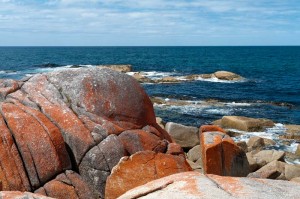We left this morning and drove the very winding and hilly road to St. Helens, which we reached just about 11. There was about 20 km of gravel road before we got to Gladstone (which is a very small town, though it did have a service station, with the most expensive diesel I’ve seen on this trip). Enid saw a tiger quoll though all I saw was it’s tail running off the road where it must have been eating a road killed wallaby, and then later we saw another one itself the victim of road kill. We also saw two wedge tailed eagles, also feasting on the road. There is an amazing number of dead animals on the highways.
We drove through the Myrtle Forest at Weldborough Pass. There are some beautiful large trees here, as well as many large ferns. At St. Helens we were going to stop at the information centre on the way into the town to check where we could get water; however, there was a market on at the centre, and so we saw no where to park. Instead we stopped at the IGA to get groceries, and then went back to the information centre later on, where we did finally get a parking spot. We got the information we needed (and filled up with water on the way out of town) and we did a bit of shopping at the market as well. We bought a few vegetables, including some parsnips which we had for supper tonight, and some more books to read.
The paved road to this campsite was about 12 km from St. Helens. There are a number of free campsites along the Binalong Bay road in the “Bay of Fires” conservation area. We don’t have as nice a site as last night, since we can’t see the ocean — all the beachfront sites, and there are quite a large number of them at this site, are taken on this long weekend. However it’s not a very long walk to the ocean, maybe 100 metres. We walked along the beach this afternoon, a very hard walk as the sand is soft, white, and granular. The beach slopes quite quickly into the ocean, so the surf break is very short and fast. There are many rocky points of weathered granite, and they are highly coloured with orange-red lichen. These coloured rocks give the bay its name.

